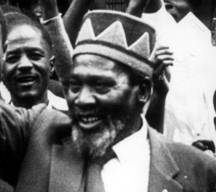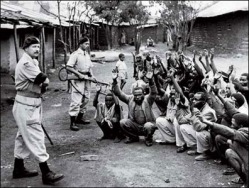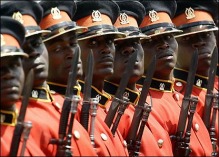Michael Song
Kenya; Struggle for Independence

For almost seven decades, Kenya was enslaved in colonization under Britain. For centuries, the native people of Kenya have lived freely and peacefully. They have thrived off their own natural resources, their own land and government system. Once filled with well-organized communities, Britain has terminated the peaceful and free lives of the Kenyan people. When the British entered, they constructed large plantations solely for the profit of the white man (Middleton para 3). The British have taken control of the government, economy, and military and have created a system that has killed off hundreds of thousands of people through famine, disease, and war (para 2).
It all started in the year 1888 when the British were allowed to exploit a section of eastern Africa. When the first groups of British settlers made camp, they often encountered locals who tried to sabotage their settlements until the year 1911 when the British had successfully taken full control. The British settlers stole the land, and made the locals their slaves who were exposed to harsh treatment and long hours working solely for the profit of their white masters. Eight years after the British’s total control, World War I broke out, 150,000 Gikuyu natives were forced to be trained to fight at the front. After the war, 100,000 returned only to be the victims of the influenza epidemic in 1919 (para 3). The White settlers then became greedy and stole the land set aside for Africans and stripped many of their land ownership rights. The society of Kenya had become stricken with poverty and aggression brought on by the settlers.
Fortunately, African intellectuals still existed and held with them the principles of human freedom, and the belief of anti-colonialism. In 1944, the Kenyan African Union was created to protest and take back what was once theirs such as land (para.9). In the Kenyan African Union, a man named Jomo Kenyatta stepped into power and led the resistance group. Soon after the British discovered these groups, Kenyatta was taken into prison, which set off bloody skirmishes between the Kenyans and the British. The Mau Mau was a militant guerilla resistance group that fought with the KAU and started the battles. The carnage lasted from 1952-1956 killing about 13,000 Kenyans (para.7). After a scandal involving the beating of eleven Kenyan detention camp prisoners by British guards, Britian finally felt guilty about their reign in Kenya, and left in 1961(para. 8). Jomo Kenyatta was now the leader of Kenya, and the peace and freedom of Kenya has been restored to its people, its land and its culture.
Now independent, Jomo Kenyatta elevated Kenya into another spectrum; one that was prosperous, and one that was peaceful. As time went on, is own party, the Kenya African National Union, was in control. There were constant coups attempts to overthrow, and the fight for control became a major issue. After Kenyatta’s death in 1978, Vice President Daniel arap MOI took the office of the president of Kenya. After a major crack down on other political factions, Moi’s presidency led to corruption and gradual economic demise (para. 9).
For years, grueling war and harsh mistreatment under British rule was daily life for the Kenyans. Only through the guidance and leadership of intellectuals such as Jomo Kenyatta were the people of Kenya able to open their eyes to see the real Kenya. After British rule, Kenyatta has led Kenya into a new era; one that would be led by Kenyans for Kenyans.
Works Cited
Middleton, John. "Kenya." Africa: An Encyclopedia for Students. 3rd ed. 4 vols. New York, 2001.
This source provided me with information about major figures, organizations and events leading to the actual independence.
Ochieng, Zachary. "Kenya's long road to independence." News From Africa. 10 Jan. 2007. 5 May 2009 <http://www.newsfromaftica.org/newsfromafrica/articles/art_10816.html>.
This gave me the chronological order for events leading to independence.
“Roots of the Kenyan Struggle for Independence." Global Literacy Project. 5 May 2009 <http://www.glpinc.org/Classroom%20Activities/Kenya%20Articles.Struggleforindependenceke
nya.html>.
This source provided the chain to events. The beating of the prisoners in Kenya were from this source.
Last Updated by Michael Song on Friday, May 22nd, 2009.


